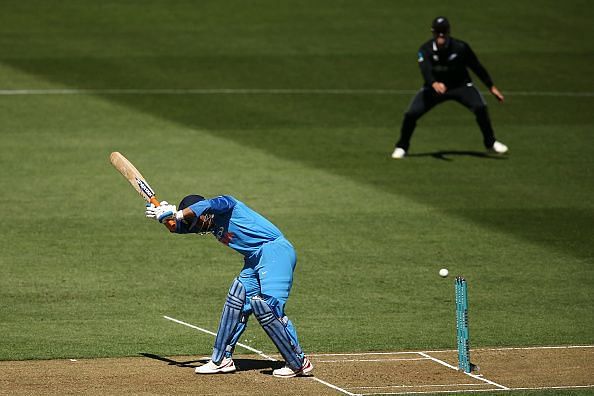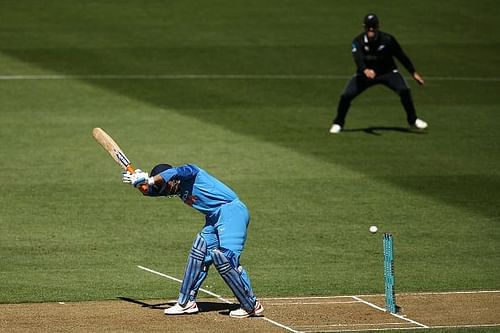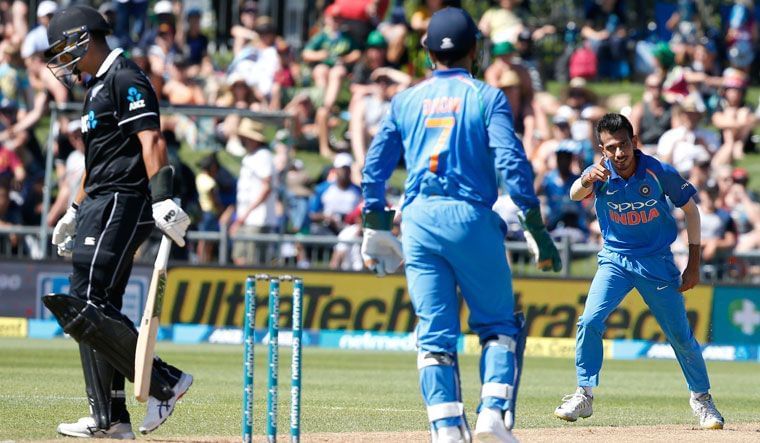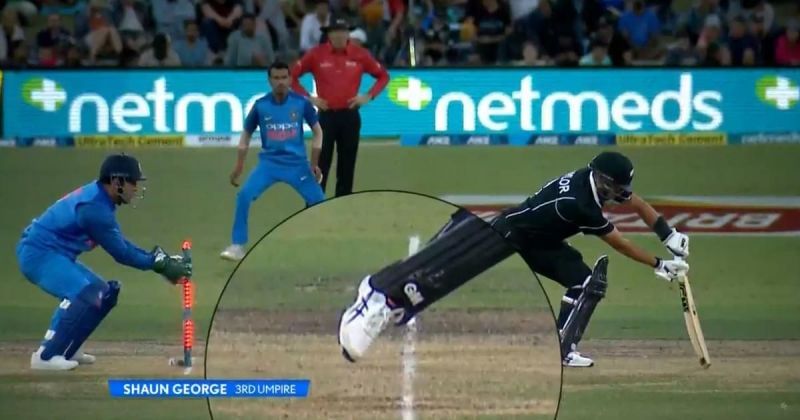
New Zealand vs India 2019: New Zealand needed an Ambati Rayudu kind of innings in the series, which they never got
The last match of the recently concluded ODI series between New Zealand and India initially threatened to be a replica of the previous one. On the Wellington pitch, which offered initial swing and bounce to the New Zealand fast bowlers, it looked like it was going to be Hamilton Part II.
A very dangerous fast bowler with boyish face, Trent Boult, was again calling the shots. He was bringing the ball back - not by a huge margin, but just enough to create confusion among India’s famed top order.
Boult's partner Matt Henry was joining the party too, generating plenty of bounce from the pitch.
India would have been hoping that Mahendra Singh Dhoni, returning after an injury absence in Hamilton, would get them out of the hole. In the absence of Virat Kohli, he was the one with the best defensive technique in the team.
But for a change, even Dhoni could not be the savior. Another brilliant Trent Boult delivery breached his unsure defense and footwork, and the stumps were rattled.
Boult, who is not a very expressive cricketer normally, could not hide his excitement at that. India were really staring at the barrel now. They had been reduced to 18 for 4, and Boult had 2 for 7.
If you accumulated his Hamilton and Wellington exploits together, he amazingly had 7 wickets for 28 runs.

For the next few overs, it was a battle for survival for India. Although Vijay Shankar started his innings with lot more assurance than his more illustrious colleagues, you could sense that there was one more wicket round the corner.
Kane Williamson, the New Zealand captain, then made one tactical change from the strategy he had executed perfectly in Hamilton. Instead of continuing with Boult, he brought his medium pacers – Colin de Grandhomme and Colin Munro.
Even they started off by generating disconcerting bounce from the pitch. India were crawling, playing lot of dot balls for a long period of time. But the rest of the story is well known by now.
With the help of Rayudu, Shankar, Kedar Jadhav and the electrifying Hardik Pandya, India made a remarkable recovery and posted a respectable 250+ score. The cornerstone of the turnaround was the partnership between Rayudu and Shankar, where both of them were prepared to patiently grind it out for a long period of time.
This was the template of an ODI innings recovery that wasn't very alien to all the teams until a few years ago. On a slightly difficult pitch, if you lose early wickets, there would be a Michael Bevan or a Mike Hussey or an Inzamam-ul-Haq who would battle hard, steady the ship, keep wickets in hand and then either explode in the slog overs or hand over the baton to the all-rounders to have a go.
However, under similar situations, the New Zealand batting did not have this template in their kit bag. They just couldn't find it; not only in this match, but in the entire series.
It was well known that both the regular New Zealand openers, Guptil and Munro, would have licenses to go for their shots right from the word go. That was the template which had produced regular 300 to 350+ scores for them in several matches recently.
Unfortunately for them, they could not execute it against Bhuvneshwar Kumar and Mohammed Shami, who bowled with better length and a bit of swing early on. Throughout the series, they failed to survive the initial overs and thus couldn't put pressure on the next set of Indian bowlers.
When you have two aggressive openers with an “all or nothing” approach, there are bound to be scenarios when they won't click. It had happened before, and will happen again. This New Zealand team always had insurance in the form of Kane Williamson and Ross Taylor, and the hope, presumably, was that they would do the rescue act again if needed.
Williamson and Taylor are both classical batsmen capable of holding one end up till the finish line. Williamson, whose back-foot play is like poetry in motion, never looks like he's hitting any ball violently. And yet he scores at an amazing rate, playing all proper cricketing shots.
Taylor can be circumspect to start with. But when he decides to accelerate, very few in the world can match his ability to clear the ropes with ease.
New Zealand needed one of these two or both of them to create partnerships with other batsmen. But the tried and tested duo couldn't do that in the series against India.
In other words, they couldn't play a Rayudu kind of innings. And that hurt the hosts throughout the series.
Let’s recap the ways Williamson and Taylor got out in the series. It started with Napier. New Zealand lost the openers early and these two were doing their familiar repairing job. The run-rate was not extraordinary, but decent enough; they were 52 for 2 in 14 overs.
But there was something amiss. It seemed like New Zealand were aiming for a 300+ score from the beginning, and were not ready to re-adjust the goal post.
One could almost sense Taylor’s eagerness to break the shackles and find the accelerator paddle. He stepped out to Yuzvendra Chahal, who smartly pulled his length back with slower pace. All Taylor could do was to offer a return catch, which Chahal picked up inches from the ground.
At the other end, Williamson was doing his job as usual. Although New Zealand lost regular wickets to the Indian spinners, they had hope till the captain was there. Then, in the 33rd over, the match was completely lost. Williamson, contrary to his usual restraint, lofted a Kuldeep Yadav leg-break straight into the hands of long-on.
They had 17 overs to go. They could only bat for another five.

In the second match at Mount Maunganui, India, with the help of a solid opening partnership and late flourishes from Dhoni and Jadhav, posted a formidable 324. But this was beautiful track and going by the strength of the New Zealand batting, the target was not insurmountable.
New Zealand again lost Guptill early. But Williamson was playing like a dream. He hit the impressive Shami for two sixes and then played a back-foot off-drive which had people going ga-ga over it. It was just sublime touch.
The very next ball rose outside off and based on what had happened in the over, Williamson should probably have left it alone. But he again jumped off his back-foot, trying to repeat the same shot, and brought the ball back to his stumps.
It was one of those beautiful little innings brought to a premature end for no rhyme or reason.
Taylor was still there though, and he knew that he would need to be there till the end. That was not to be as he fell to Jadhav. More appropriately, he fell to Dhoni’s brilliance behind the stumps.
New Zealand's hope almost vanished right there.

In the third match, at the same venue as the second, New Zealand batted first and for the third time in a row, lost the openers early. Williamson and Taylor again had to do a repair job, and they did much better this time.
Williamson was unlucky to fall to a brilliant catch by Pandya. But Taylor played one of the best grinding knocks of the series, starting slowly, playing a lot of dot balls and putting the bad ones away. He even forged a strong partnership with Tom Latham, which for the first time in the series, was looking threatening to India.
Latham gave it away after reaching 50, lobbing Chahal to the deep. New Zealand still had twelve and a half overs in hand. If Latham was there, they could have scored much more than the eventual 65 they got from the remaining overs.
After inflicting a heavy defeat on India in the 4th match, New Zealand again were in a winning position in the 5th. They had to chase a mere 252, in spite of a brilliant recovery from India. Like clockwork, they again lost both the openers early.
But this was an ideal situation for Williamson and Taylor. The asking run-rate was not that demanding. They had to play normal cricket and take the score as close as possible to India's.
It was not to be. At first, Taylor was hit on his pad in front of the stumps by Pandya. Although it was straight, there was always doubt about the height. Taylor thought that it was high too and checked with his non-striker and, for some inexplicable reason, they decided not to review. The replay showed that the ball was going over the stumps.
Still, Williamson was still at the crease. He is known to finish such games. New Zealand were 105 for 3 in the 26th over and Williamson and Latham were in the middle of a good partnership. They just had to carry on till maybe the 40th over to win the match for New Zealand.
However, out of nowhere, Williamson dragged an almost half-tracker from Jadhav into the hands of Dhawan in the deep. That, in essence, was typical of New Zealand's showings in the series. Their top batsmen failed to grind the way Rayudu and Shankar did in that crucial period of the 5th match.
The 4-1 series win, although well-deserved from India’s point of view, does not make New Zealand a bad team overnight. They have depth in both batting and bowling, and would be one of the teams to beat in the upcoming World Cup 2019. However, they have to keep in mind that there would be days when their opening pair would not fire and the rest of the top order would have to be ready to grind it out.
For a long time, New Zealand batsmen have played ODIs like extended T20s. That has to change now. Their key players, especially Williamson and Talyor, have to be ready to play some periods like a Test innings, depending on the match situation.
It’s a learning curve for the New Zealand team and they are lucky that this realization did not come during the course of the World cup. They are on the wrong side of the result, but at the right side of time.
With a batting lineup full of class and raw power, they are expected to turn it around in the next few months. If they do that, they would definitely be a force to reckon with.